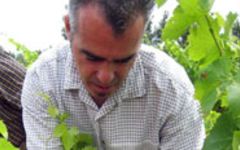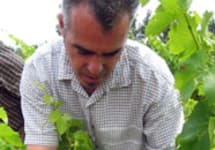Clos du Caillou Chateauneuf-du-Pape Reserve 2001
-
Robert
Parker -
Wine
Spectator


Product Details
Your Rating
Somm Note
Winemaker Notes
Professional Ratings
-
Robert Parker's Wine Advocate
An off-the-charts effort that was one of my wines of the trip, the 2001 Chateauneuf du Pape Reserve Le Clos du Caillou is a spectacular effort that doesn’t put a foot wrong. Getting a bevy of incredible, spectacular, and a few other adjectives (i.e. expletives) in the notes, this rock-star-of-a-Chateauneuf boasts off-the-hook notes of blackcurrants, saddle leather, beef blood, pepper, spring flowers and licorice. Possessing full-bodied richness on the palate, with beautiful underlying structure and depth, this incredible effort represents the essence of this fabulous terroir, and is a thrilling drink that I wish every Rhone- lover could have the opportunity to taste.
-
Wine Spectator
This is rolling along, slowly unwinding its dark, mulled fig, currant paste and blackberry pâte de fruit notes. The still-dense, fleshy and youthful fruit is melding with more-mature hints of roasted apple wood, briar, espresso and smoldering ash notes that stretch out through the long, richly detailed finish. Impressive now, and should cruise for another decade.—2001 Châteauneuf-du-Pape non-blind retrospective (November 2011). Drink now through 2022
Other Vintages
2021- Decanter
-
Robert
Parker -
Jeb
Dunnuck -
Wine
Spectator -
James
Suckling
-
Robert
Parker -
Wine
Spectator -
Jeb
Dunnuck
-
Jeb
Dunnuck - Decanter
-
Robert
Parker -
Wine
Spectator -
James
Suckling
-
Robert
Parker -
Jeb
Dunnuck -
Wine
Spectator
-
Jeb
Dunnuck -
Robert
Parker
-
Robert
Parker -
Wine
Spectator -
James
Suckling -
Jeb
Dunnuck - Decanter
-
Robert
Parker
-
Robert
Parker -
Wine
Spectator
-
Robert
Parker
-
Robert
Parker -
Wine
Spectator
-
Robert
Parker
-
Robert
Parker
-
Wine
Spectator -
Robert
Parker
-
Wine
Spectator -
Robert
Parker
-
Robert
Parker
-
Robert
Parker


—Robert Parker, The Wine Advocate
From robust Côtes-du-Rhône to memorable Chateauneuf-du-Pape, Clos du Caillou wines arguably represent some of the finest values in all of France. Proprietor Sylvie Vacheron and winemaker Bruno Gaspard are keeping the great work of the late Jean-Denis Vacheron alive with wines that are heady, robust and mouth-wateringly lush.
Caillou tends wonderfully old Grenache vines, some of which are 70 to 100 years old. With older Syrah and Mourvèdre added to the mix, it’s no wonder that Caillou wines are across the board impressive for their power, extract and deep minerality. The estate’s Chateauneuf terroir borders the impressive domaines of Chateau Rayas and Beaucastel.
Yet many of the Vacheron-Pouizin family's old vines are classified, by a quirk of 1923 politics, Côtes-du-Rhône and Côtes-du-Rhône-Villages. It’s why our Côtes-du-Rhône barrel selections show surprisingly like its kin in Chateauneuf-du-Pape.
In 1996 Jean-Denis Vacheron took full control of the viticulture and élévage at this estate. Under his stewardship, the wines of Caillou steadily gained stature, and today are benchmarks for the appellation. He understood that temperature-controlled fermentation and a cool, clean cellar are necessary to craft wines with refinement and true complexity.

With bold fruit flavors and accents of sweet spice, Grenache, Syrah and Mourvèdre form the base of the classic Rhône Red Blend, while Carignan, Cinsault and Counoise often come in to play. Though they originated from France’s southern Rhône Valley, with some creative interpretation, Rhône blends have also become popular in other countries. Somm Secret—Putting their own local spin on the Rhône Red Blend, those from Priorat often include Merlot and Cabernet Sauvignon. In California, it is not uncommon to see Petite Sirah make an appearance.

Famous for its full-bodied, seductive and spicy reds with flavor and aroma characteristics reminiscent of black cherry, baked raspberry, garrigue, olive tapenade, lavender and baking spice, Châteauneuf-du-Pape is the leading sub-appellation of the southern Rhône River Valley. Large pebbles resembling river rocks, called "galets" in French, dominate most of the terrain. The stones hold heat and reflect it back up to the low-lying gobelet-trained vines. Though the galets are typical, they are not prominent in every vineyard. Chateau Rayas is the most obvious deviation with very sandy soil.
According to law, eighteen grape varieties are allowed in Châteauneuf-du-Pape and most wines are blends of some mix of these. For reds, Grenache is the star player with Mourvedre and Syrah coming typically second. Others used include Cinsault, Counoise and occasionally Muscardin, Vaccarèse, Picquepoul Noir and Terret Noir.
Only about 6-7% of wine from Châteauneuf-du-Pape is white wine. Blends and single-varietal bottlings are typically based on the soft and floral Grenache Blanc but Clairette, Bourboulenc and Roussanne are grown with some significance.
The wine of Chateauneuf-du-Pape takes its name from the relocation of the papal court to Avignon. The lore says that after moving in 1309, Pope Clément V (after whom Chateau Pape-Clément in Pessac-Léognan is named) ordered that vines were planted. But it was actually his successor, John XXII, who established the vineyards. The name however, Chateauneuf-du-Pape, translated as "the pope's new castle," didn’t really stick until the 19th century.
